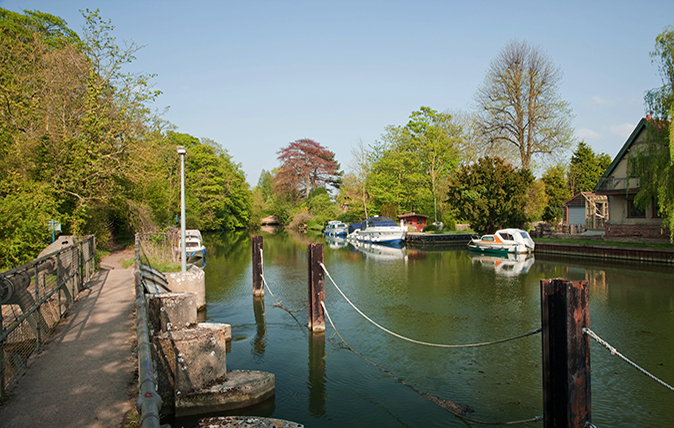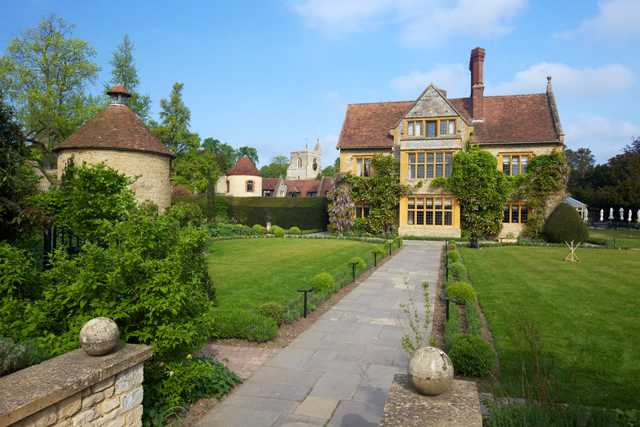The best places to live for commuters: Oxfordshire
There are a good number of villages and towns in Oxfordshire on our list of the best places to live near London for commuters.


Sutton Courtenay
Commute: Didcot Parkway (London Paddington, 44 minutes). Drive to station: about 10 minutes. Frequency of trains: 5 per hour (peak). First train in: 4.12am; last train home: 12.22am. Annual season ticket: £4,832. Annual car-park ticket: £779.50-£1,217.
The Country Life verdict: Former Prime Minister Herbert Asquith and George Orwell are buried in the graveyard of this Thames-side village. Didcot, by no means a beauty, is, nevertheless, a desirable commuting station - great views of the Thames valley will soothe your journey - which people regularly drive to from the edge of the Cotswolds or Berkshire Downs villages.
Best house: The Mill House (now owned by Helena Bonham Carter and Tim Burton) is ‘an amazingly gorgeous 17th-century house on the river', says Damian Grey of Knight Frank Oxford. We also like the Manor House.
Alternative: Drayton, Milton.
Dorchester-on-Thames
Commute: Didcot Parkway (London Paddington, 44 minutes). Drive to station: about 19 minutes. Frequency of trains: 5 per hour (peak). First train in: 4.12am; last train home: 12.22am. Annual season ticket: £4,832. Annual car-park ticket: £779.50-£1,217.
Sign up for the Country Life Newsletter
Exquisite houses, the beauty of Nature, and how to get the most from your life, straight to your inbox.
The Country Life verdict: According to Damian Gray of Knight Frank, lots of owners of big country houses in the area will only consider downsizing if he can find them something in this lively village. There's a proper high street with lots of shops and pubs and the village organises an annual music event, the Dorchester-on-Thames Festival. We also like it because, nearby, is Day's Lock, where the annual World Pooh Sticks Championship is held.
Best address: The Manor House, off the High Street, which is within walking distance of the abbey, says Mr Gray.
Alternatives: Long and Little Wittenham (home to Earth Trust, a conservation organisation that owns 1,200 acres).
Henley-on-Thames
Commute: Twyford (London Paddington, 34 minutes). Drive to station: about 14 minutes. Frequency of trains: 8 per hour (peak). First train in: 4.47am; last train home: 12.34pm. Annual season ticket: £3,448. Annual car-park ticket: £1,085.
The Country Life verdict: This famous riverside market town has a high concentration of glitterati and Champagne Socialists in residence, according to Nicholas Brown of Knight Frank Henley. Peripheral residential roads are lined with large houses boasting wrought-iron (electric) gates topped with eagles. Living in town is noisier and busier, especially during the Regatta.
Best address: ‘New Street is a very pretty stretch of Georgian town houses,' recommends Mr Brown.
Alternative: Wargrave.
Sonning
Commute Twyford (London Paddington, 34 minutes). Drive to station: about 7 minutes. Frequency of trains: 8 per hour (peak). First train in: 4.47am; last train home: 12.34pm. Annual season ticket: £3,448. Annual car-park ticket: £1,085.
The Country Life verdict: A busy village with two hotels, a pub, an Indian restaurant and its own theatre - The Mill at Sonning. The Sonning Festival, including a regatta, is held every two years.
Best address: Lutyens's The Deanery, built for Edward Hudson, founder of Country Life.
Alternative: Waltham St Lawrence.
Stratton Audley
Commute: Bicester North (London Marylebone, 50 minutes). Drive to station: about 10 minutes. Frequency of trains: 2 per hour (peak). First train in: 5.33am; last train home: 12.05am. Annual season ticket: £4,692. Annual car-park ticket: £1,040
The Country Life verdict: Bicester isn't surrounded by many lovely villages - this is one of the few, so property here is a safe bet. The retail outlet Bicester Village has become something of a landmark and tourists from South-East Asia are regularly shuttled there direct from Heathrow. Chiltern Railways plans to reopen the ‘Varsity Line' to Oxford, so the village will make an excellent spot for commuting there as well.
Best address: Stratton Audley Park is an imposing house with fantastic views, says Damian Gray of Knight Frank.
Alternatives: Stoke Lyne and Marsh Gibbon.
Great Milton
Commute: Haddenham & Thame Parkway (London Marylebone, 39 minutes). Drive to station: about 13 minutes. Frequency of trains: 3 per hour (peak). First train in: 5.44am; last train home: 12.05am. Annual season ticket: £3,880. Annual car-park ticket: 1,040.
The Country Life verdict: The manor house is now Raymond Blanc's Le Manoir aux Quat' Saisons, so this village comes with a certain glamorous pedigree. Unspoilt, rural idyll with plenty going on. The popularity of commuting from Haddenham & Thame Parkway exploded after the multi-storey car park there was built.
Best address: Romeyns Court, which used to be owned by Sir Tim Rice, gets the Knight Frank vote.
Alternatives: Great Haseley, Little Haseley.

Hethe
Commute: Bicester North (London Marylebone, 50 minutes). Drive to station: about 14 minutes. Frequency of trains: 2 per hour (peak). First train in: 5.33am; last train home: 12.05am. Annual season ticket: £4,692. Annual car-park ticket: £1,040.
The Country Life verdict: The Muddy Duck, the village pub, is recommended by Iain Powis of Savills Banbury, who describes Hethe as ‘a lovely part of the world'.
Best Address: Hethe House.
Alternatives: Fringford.
Blewbury
Commute: Didcot Parkway. Drive to station: about 11 minutes. Frequency of trains: 5 per hour (peak). First train in: 4.12am; last train home: 12.22am. Annual season ticket: £4,832. Annual car-park ticket: £779.50-£1,217.
The Country Life verdict: This is a big but charming village with a lively social scene as well as a welcoming pub, a football club, a cricket green, a brass band, a church choir, an amateur-dramatic society, a post office, shop and equestrian centre. Within easy reach of the Ridgeway and glorious Berkshire Downs.
Best address: Blewbury Manor is a beautiful house with nationally acclaimed gardens, says Damian Gray of Knight Frank.
Alternatives: Aston Tirrold and Aston Upthorpe-these two charming villages behave as one community, with lots of classic cob walling, thatched cottages and flint-and-brick houses. There's a good gastropub, The Sweet Olive, and plenty of activity in the village hall, including a weekly post office.
** Read the entire list of the best places to live near London
Country Life is unlike any other magazine: the only glossy weekly on the newsstand and the only magazine that has been guest-edited by HRH The King not once, but twice. It is a celebration of modern rural life and all its diverse joys and pleasures — that was first published in Queen Victoria's Diamond Jubilee year. Our eclectic mixture of witty and informative content — from the most up-to-date property news and commentary and a coveted glimpse inside some of the UK's best houses and gardens, to gardening, the arts and interior design, written by experts in their field — still cannot be found in print or online, anywhere else.
-
 'There is nothing like it on this side of Arcadia': Hampshire's Grange Festival is making radical changes ahead of the 2025 country-house opera season
'There is nothing like it on this side of Arcadia': Hampshire's Grange Festival is making radical changes ahead of the 2025 country-house opera seasonBy Annunciata Elwes Published
-
 Jungle temples, pet snakes and the most expensive car in the world: Country Life Quiz of the Day, April 14, 2025
Jungle temples, pet snakes and the most expensive car in the world: Country Life Quiz of the Day, April 14, 2025Mondays's quiz tests your knowledge on English kings, astronomy and fashion.
By James Fisher Published
